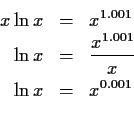BUILDING ADDITIONAL ITERATORS
It is easy to see that we can create an infinite number of iterators.
For instance, for any iterator x = F(x)
will also be fixed point iterator giving the same solution set
for any  .
However arbitrary iterators may not be better.
Iterators with fewer occurrences of the unknown variable are
generally better.
.
However arbitrary iterators may not be better.
Iterators with fewer occurrences of the unknown variable are
generally better.
Using iterators which have the minimal number of occurrences of
the unknown, guarantees to a certain degree, that we will not be
generating more complicated trivial iterators.
If at any point during our isolation or after trial simplification,
the resulting equation has a smaller number of occurrences of x,
we will derive all possible iterators arising from this shortened
equation.
For example,
The grouping of powers caused a simplification and from this
equation we obtain two iterators
The first one was obtained before but the second one is
new and in this case it is useful to find the largest
of the roots of the original equation.
This is not surprising as the new iterator has only two occurrences
of the variable and falls under the previous theorem.

